Effect of Diethyl Carbonate as Additive to Waste Plastic Oil on Performance and Emission of a Diesel Engine
Pappula Bridjesh1 and Narayanan Kannaiyan Geetha2*
1Department of Mechanical Engineering, MLR Institute of Technology, Hyderabad 500043, India
2Department of Science and Humanities, Sri Krishna College of Engineering and Technology, Coimbatore 641008, India
Corresponding Author E-mail: nkgeeth@gmail.com
DOI : http://dx.doi.org/10.13005/ojc/360125
Article Received on : 11 Jan 2020
Article Accepted on : 12 Feb 2020
Article Published : 13 Feb 2020
Usage of oxygenated fuels either as replacement to fossil fuels or as additives to fossil fuels and alternative fuels is given much interest. Diethyl Carbonate (DEC) is an oxygenated additive which is non-toxic in nature and biodegradable as well. The objective of this study is to replace utilization of diesel fuel on diesel engine by 50 vol% with Waste Plastic Oil (WPO). This study also analyses the effect of addition of DEC in proportions of 5, 10 and 15 vol% to WPO on performance and emission of a diesel engine. Test fuels D50WPO50 (50% diesel + 50% WPO), D50WPO45DEC5 (50% diesel + 45% WPO + 5% DEC), D50WPO40DEC10 (50% diesel + 40% WPO + 10% DEC) and D50WPO35DEC15 (50% diesel + 35% WPO + 15% DEC) were prepared. Tests were conducted on a single cylinder diesel engine at 20%, 40%, 60%, 80% and 100% load. The results of performance and emission characteristics of test fuels were compared with diesel fuel. Test results show that the spray effect of DEC has increased brake thermal efficiency and reduced brake specific fuel consumption. Addition of DEC to WPO-diesel blends not only optimize the burning process but also minimize engine exhaust emissions. The problems of fuel energy crisis and plastic waste management can be addressed simultaneously with production and utilization of fuel produced from plastic wastes.
KEYWORDS:Diethyl Carbonate; Diesel Engine; Oxygenated Additive; Waste Plastic Oil
Download this article as:| Copy the following to cite this article: Bridjesh P, Geetha N. K. Effect of Diethyl Carbonate as Additive to Waste Plastic Oil on Performance and Emission of a Diesel Engine. Orient J Chem 2020;36(1). |
| Copy the following to cite this URL: Bridjesh P, Geetha N. K. Effect of Diethyl Carbonate as Additive to Waste Plastic Oil on Performance and Emission of a Diesel Engine. Orient J Chem 2020;36(1). Available from: https://bit.ly/2SFjjjv |
Introduction
Technically products like coal, alcohols, gas oil, heavy oil, diesel, petrol etc., are used as fuels. However, petroleum products such as diesel and gasoline are being used as fuels for internal combustion engines widely. The depletion of fossil fuels, price of crude oil and environmental considerations forced the engine manufacturers to look for alternative fuels1. With the rapid development in engine technology, a few alternative fuels being utilized on engines as blends. It is desirous to replace fossil fuels with alternative fuels. The greatest dis-advantages to adapt most of the alternative fuels in neat form are viscosity, calorific value incomplete combustion and higher exhaust gas emissions. In this regard, chemical additives play a vital role not only to enhance the properties of alternative fuels but also to achieve the desired performance2. The advantages of using additives to fuel are very well documented in literature3-6. The selection, composition and concentration of fuel additive are also important consideration for value additions. The crux of additive concentration depends upon the chemical composition of fuel and chemistry of mixture. A lot of research is explored in this direction to determine the optimum dosage of additive7.
In case of biodiesels, despite having numerous advantages, the adoptability is hindered due to low quality of fuel8. Degradation of biodiesel in various ways is still a challenge to fuel production units and researchers. Removal of hydrogen from biodiesel improves the auto oxidation and crystallization of fatty acids increases the cold flow properties of biodiesel. Likewise, the biodiesel is also degraded due to microbial activities9. A synthetic additive could be used to overcome the degradation of biodiesel10. Another undesirable aspect related to biodiesel combustion is the formation of oxides of nitrogen11. Various means and methods are proposed by researchers to mitigate the NOx formation to some extent such as pre combustion method12, exhaust gas recirculation, selective catalytic converter13, water emulsion14, using nano additives15 and interestingly oxygenated additives are as well used16. Oxygenated additives in various concentrations such as ethanol17, decanol18, hexanol19, butanol20 are added to various biodiesels.
Synthetic fuels such as waste plastic oil (WPO) and tyre pyrolysis oil have also been used as fuels on diesel in the recent years. Conversion of plastic waste and waste tyres into useful energy not only reduces environmental pollution but also serves as a source of fuel for engines and boilers21. The molar mass of WPO is higher than that of diesel22. Even though the properties of WPO are very close to diesel, a few properties such as calorific value, viscosity, and cetane number are very much inferior to diesel. It is reported in the literature that those properties which are inferior to WPO can be improved by adding suitable chemical additives23. Addition of diethyl ether to WPO has increased the atomization of fuel. However, the concentration of NOx emission was found to be higher24. Addition of n-butanol to WPO has reduced NOx and smoke emission at the expense of brake thermal efficiency25.
It is inferred from the literature that the use of additives and in specific, oxygenated additives to WPO is not much explored. Diethyl Carbonate (DEC) is an oxygenated additive which is non-toxic in nature and biodegradable as well. The present experimental investigation encompasses the analysis of performance and emission from diesel engine using DEC as chemical additive to WPO. It is another objective of the present study to substitute 50 vol% of diesel with mixture of WPO and DEC.
Experimental Methods
The slogan “Don’t Waste, Waste”26 is a call unto mankind to harness plastic waste into useful energy source. It is a fact that plastic waste is not biodegradable. The problem of piling up of plastic waste as landfills and energy crisis can be addressed simultaneously by converting plastic waste into fuel. Pyrolysis process has received good reputation in converting plastic waste into useful by-products. In general, the products of pyrolysis are gases with higher aromatic hydrocarbons, gases with lower hydrocarbons and solid char. The gases are condensed in a condenser, to produce WPO. The detailed explanation about the production of WPO, experimental setup and operating procedure were presented by the authors in2, 21. The FTIR spectrum of WPO is presented in Figure 1 and the properties of WPO are tested as per ASTM standard and presented in Table 1.
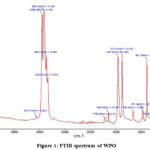 |
Figure 1: FTIR spectrum of WPO |
Table 1: Properties of WPO
| Property | Diesel | WPO | DEC | ASTM method |
| Density @15 °C (kg m-3) | 835 | 893 | 975 | D4052 |
| Calorific value (MJ kg-1) | 45.4 | 41.2 | — | D240 |
| Kinematic viscosity (cSt) | 2.15 | 3.12 | — | D445 |
| Flash point (°C) | 49 | 58 | 25 | D93 |
| Boiling point (°C) | 180-330 | 120-375 | 126 -128 | D7169-16 |
| Self-ignition temperature (°C) | 210 | 261 | 445 | D1929-16 |
| Cetane number | 53 | 31 | 58 | D4737 |
| Oxygen content (wt%) | 0.03 | 0.31 | 40.6 | – |
Oxygenated compounds such as alkyl carbonates are considered as promising additives. DEC (CAS Number: 105-58-8) is a liquid at room temperature and has very intrinsic properties such as low flash point, high boiling point which makes it a desirable additive to fuel and it also minimizes vapour buildup. As WPO is produced in inert atmosphere, there is no oxygen present in WPO and this can be compensated with the use of DEC as such 40.6 wt% of oxygen is present in DEC. the structure of DEC is presented in Figure 2. For the present study, DEC was purchased from MERCK, India. DEC is added to WPO in proportions of 5, 10 and 15 vol%. The nomenclature of test fuels used in this study is presented in Table 2.
Table 2: Nomenclature of test fuels
| S.No | Test Fuel (Nomenclature) | Composition |
| 1 | Diesel | 100 % diesel |
| 2 | D50WPO50 | 50% diesel + 50% WPO |
| 3 | D50WPO45DEC5 | 50% diesel + 45% WPO + 5% DEC |
| 4 | D50WPO40DEC10 | 50% diesel + 40% WPO + 10% DEC |
| 5 | D50WPO35DEC15 | 50% diesel + 35% WPO + 15% DEC |
| 6 | WPO | 100% WPO |
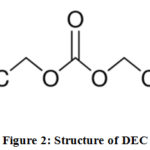 |
Figure 2: Structure of DEC |
Results and Discussion
The effect of DEC as additive with WPO on performance and emission characteristics of diesel engine as compared with diesel fuel is presented below:
Effect of DEC on Performance Characteristics
The fuels for diesel engines are devised to improve combustion and increase efficiency. Inherently diesel fuel comprises of long and short chains of alkanes and alkenes along with aromatic molecules. With increase in the alkyl chain length, despite the start of ignition remain the same but start of combustion decreases and thus, the ignition delay period reduces27. With decrease in ignition delay period, the secondary atomization is promoted with higher rate of evaporation of fuel air mixture. This results in increased brake thermal efficiency (BTE). The influence of DEC with WPO on BTE and of other test fuels is presented in Figure 3. BTE increases with increase in the load for all test fuels and this is a general trend2. The higher amount of oxygen present in DEC enhances the chemical reaction between fuel and air to improve combustion. BTE is found to be increasing with increase in DEC composition. As compared with WPO, BTE for D50WPO45DEC5, D50WPO40DEC10 and D50WPO35DEC15 was found to be higher by 3.62%, 4.00% and 6.93% respectively. As compared with diesel, BTE for D50WPO45DEC5, D50WPO40DEC10 and D50WPO35DEC15 was found to be lower by 1.88%, 4.88% and 5.05% respectively. Further, as compared with D50WPO50, BTE for D50WPO45DEC5, D50WPO40DEC10 and D50WPO35DEC15 was found to be higher by 3.43%, 0.38% and 0.21% respectively.
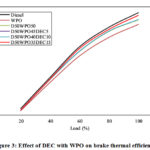 |
Figure 3: Effect of DEC with WPO on brake thermal efficiency |
It is also worth noting that the properties of DEC, in specific, flash point and cetane number enhance the combustion phenomenon. As compared with other test fuels (Table 1), flash point of DEC is much lower and cetane number is higher. With lower flash point, the heat generation rate increases, which has an instantaneous positive effect on ignition delay period and this is seen predominant with increase in DEC composition. The higher premixed combustion due to the presence of DEC might have led to the constant volume combustion allowing the formation of lean mixtures and the same shall be seen as reduced fuel consumption, presented in Figure 4. The brake specific fuel consumption (BSFC) was found to be lower for DEC blended fuels than other fuels, exception for diesel and the increase was higher with higher in amount of DEC. As compared with WPO, BSFC for D50WPO45DEC5, D50WPO40DEC10 and D50WPO35DEC15 was found to be lower by 11.27%, 9.32 and 6.94 respectively. As compared with diesel BSFC for D50WPO45DEC5, D50WPO40DEC10 and D50WPO35DEC15 was found to be higher by 1.71%, 3.82% and 6.29% respectively. The lower calorific value of blends of WPO with DEC could also be responsible for additional fuel consumption to compensate the desired power output from the engine25.
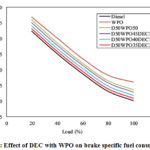 |
Figure 4: Effect of DEC with WPO on brake specific fuel consumption |
Effect of DEC on Emission Characteristics
Considerable amount of attention should be paid upon engine exhaust gas emissions. Especially NOx, HC, CO and smoke causes local air pollution and change in climate. The effect of DEC on NOx, HC, CO and smoke are presented below:
The diagram for effect of DEC with WPO and other test fuels on NOx emission is presented in Figure 5. NOx emission using WPO is higher than other fuels which may be attributed to the aromatic nature of WPO. Whereas, for blends of DEC with WPO, NOx emission was found to be lower than diesel for all concentrations of DEC. However, the NOx emission was found increasing with increase in DEC percentage for WPO-DEC test fuels. As compared with diesel, NOx emission for D50WPO45DEC5, D50WPO40DEC10 and D50WPO35DEC15 was found to be lower by 15.91%, 11.98% and 2.91% respectively. The decrease in NOx emission for WPO-DEC test fuels may be accredited that the oxygenated charge enhances premixed auto ignition there by producing reduced local in-cylinder temperatures28.
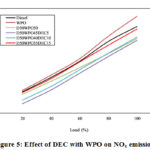 |
Figure 5: Effect of DEC with WPO on NOx emission |
The carbon-carbon bond in the DEC contribute to oxidation of Hydrocarbon (HC) and is seen as reduction in HC emission using blends of WPO with DEC, presented in Figure 6. As compared with diesel, HC emission for D50WPO45DEC5, D50WPO40DEC10 and D50WPO35DEC15 was found to be lower by 11.11%, 23.89% and 42.67% respectively. This reduction of HC emission may be attributed to the complete combustion due to the presence of oxygen in DEC. whereas, HC emission for WPO and D0WPO50 was found to be higher than diesel by 28.72% and 17.67% respectively. Increase in HC emission for WPO and D50WPO50 is likely to be produced because of quenching around the walls of engine cylinder and get discharged during the expansion stroke29.
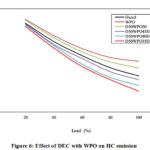 |
Figure 6: Effect of DEC with WPO on HC emission |
The effect of DEC with WPO and other test fuels on Carbon Monoxide (CO) emission is shown in Figure 7. As compared with diesel, CO emission for D50WPO45DEC5, D50WPO40DEC10 and D50WPO35DEC15 was found to be lower by 20.72%, 30.63% and 41.44% respectively. Studies on chemical kinetics of DEC reveal that the bond between oxygen and carbon oxidizes CO into CO230. Addition of DEC not only improves combustion conditions but also reduces the incomplete losses. As compared with diesel, CO emission for WPO and D50WPO50 was found to be higher by 8.26% and 3.86% respectively.
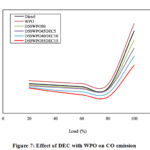 |
Figure 7: Effect of DEC with WPO on CO emission |
Oxygen enriched combustion significantly reduces smoke31. Formation of lean mixture in combustion chamber and duration of ignition delay are promoted by volatility of fuel. DEC, being a highly volatile additive promotes the formation of lean mixture. The effect of DEC with WPO and other test fuels on smoke is presented in Figure 8. Significant reduction in smoke was observed with DEC as additive. As compared with diesel, smoke using D50WPO45DEC5, D50WPO40DEC10 and D50WPO35DEC15 fuels was found to be lower by 4.10%, 6.30% and 11.50% respectively. The unique structure of DEC having oxygen atom in between carbon bonds increases the tendencies for complete combustion.
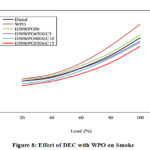 |
Figure 8: Effect of DEC with WPO on Smoke |
Conclusion
Utilisation of alternative fuels on diesel engines continues with their advantages being numerous. This study presents the analysis on performance and emission of diesel engine using DEC as additive to WPO. The results of experimental test were compared with diesel fuel. The following conclusions were drawn
The physical and chemical properties of WPO, D50WPO50, D50WPO45DEC5, D50WPO40DEC10 and D50WPO35DEC15 are acceptable and favourable to be used as fuels.
The kinetics of chemical reactions and spray effect of DEC increased BTE and reduced BSFC for DEC-WPO test fuels.
With reduced premixed auto ignition, the local in-cylinder temperatures were reduced thereby NOx emission was reduced significantly in DEC-WPO blends.
The incomplete combustion losses were highly reduced with addition of DEC to WPO thereby reducing HC and CO emissions.
Oxygen enriched combustion with addition of DEC has significantly reduced smoke emissions
It is obvious that optimum dosages of additive is very much essential for increasing the engine performance and reduce exhaust emissions.
In summary, the problems of fuel energy crisis and plastic waste management can be addressed simultaneously with production and utilization of fuel produced from plastic wastes. DEC should make a favorable additive for WPO and diesel blends. It is concluded that, addition of DEC to WPO-diesel blends not only optimizes the burning process but also minimize engine exhaust gas emissions.
Acknowledgments
The authors would like to thank Ms. TEENUJA BRIDJESH, for having given the necessary facilities to publish the findings of this research in the form of technical paper. The author also express gratitude to his superiors, peers and colleagues who were instrumental in providing their rich experience, suggestions and guidance which resulted in shaping the technical paper to the current form.
Conflicts of Interest
The authors declare that they have no any conflicts of interest.
References
- Srivastava, S. P; Jenő Hancsók.Fuels and Fuel-Additives, John Wiley & Sons.2014.
CrossRef - Bridjesh, P.;Periyasamy, P.;Geetha, N. K.;Orient J Chem.2018, 34(6), 2806-2813.
CrossRef - Prabhahar, M.; Sendilvelan, S.; Xavier, J. F.;Orient J Chem.2017, 33 (6), 2937-2941.
CrossRef - Singh, D. P.; Maurya, N. S.;Orient J Chem.2016, 32 (3), 1373-1380
CrossRef - Nixon, J. D.; Dey, P. K.; Ghosh, S. K.;Sustainable Energy Technol Assess. 2017, 21, 23–32.
CrossRef - Hadi, A. J.; Abdulkadir, H. K.; Hadi, G. J.; Yusoh, K. B.; Hasany, S. F.;Orient J Chem. 2018, 34 (2), 1069-1077.
CrossRef - Prabhahar, M.;Sendilvelan, S.; Xavier, J. F.;Orient J Chem.2017, 33(6).
CrossRef - Anwar, A.;Garforth, A.; Fuel.2016, 173, 189–208.
CrossRef - Ibrahim, L.;Weiming, Z.; Aisha, L. I.; Yifan, J.; Mingxin, Z.; Liwei, W.; Zhanhui, Y. Fuel Processing Technol.2020, 198,106228.
CrossRef - Araújo, S. V.; Luna, F. M. T.; Jr,E.M.R.;Azevedo, D.C.S.; Jr, C.L.C.; Fuel Process Technol. 2009, 90 (10), 1272–1277.
CrossRef - Sama, A.; Mortaza, A.; Meisam, T.; Ali, H.; Bahman, N.; Hassan, S. G.; Hajar, R.; Homa, H.; Pouya, M.; Energy Convers Manage.2020, 203, 112245.
- Aghbashlo, M.; Tabatabaei, M.; Khalife, E.; Roodbar, S. T.;Dadak, A.;Energy.2018, 149, 967–978.
CrossRef - Muthiya, S. J.; Pachamuthu, S.;Int J Green Energy.2018, 15, 314–324.
CrossRef - Aghbashlo, M.; Tabatabaei, M.; Khalife, E.; Najafi, B.; Mirsalim, S. M.; Gharehghani, A.; Fuel.2017, 205, 262–271.
CrossRef - Ooi, J. B.; Ismail, H. M.; Swamy, V.; Wang, X.; Swain, A. K.; Rajanren, J. R.;Energy Fuels.2016, 30, 1341–1353.
- Tabatabaei, M.; Aghbashlo, M.; Najafi, B.; Hosseinzadeh, B. H.; Ardabili, S. F.; Akbarian, E.; J Clean Prod.2019, 223, 466–486.
CrossRef - Hulwan, D. B.; Joshi, S. V.;Appl Energy.2011, 88(12), 5042–5055.
CrossRef - Ashok, B.; Nanthagopal, K.; Darla, S.; Chyuan, O. H.; Ramesh, A.; Jacob, A.; Energy.2019, 173, 494–510.
CrossRef - Ramesh, A.; Ashok, B.; Nanthagopal, K.; Ramesh, P. M.;Tambare, A.; Mali, P.; Fuel.2019, 249, 472–485.
CrossRef - Çelebi, Y.; Aydın, H.;Fuel.2018, 222, 385–393.
CrossRef - Bridjesh, P.; Periyasamy, P.; Krishnachaitanya, A. V.; Geetha, N. K.;Sustain Environ Res.2018, 28(3), 142-147.
CrossRef - Pappula, B.;Periyasamy, P.; Krishnan, P.;Geetha, N.K.; SAE Technical Paper.2018, 2018-28-0018.
- Damodharan, D.; Sathiyagnanam, A. P.; Rana, D.; Saravanan, S.; Rajeshkumar,B.;Sethuramasamyraja, B.;Energy ConversManage.2018, 166, 81–97.
CrossRef - Devaraj, J.; Robinson, Y.; Ganapathi, P.;Energy.2015, 85, 304–309.
CrossRef - Damodharan, D.; Sathiyagnanam, A. P.; Rana, D.; Rajeshkumar, B.;Saravanan, S.;Energy Convers Manage.2017, 131, 117–126.
CrossRef - Sultan Al-Salem.; Plastics to Energy, 1st Ed, William Andrew.2019
- Paul, H.; Midhat, T.; Aaron, E.; Nicos, L.; ProcIMechE Part D: J Automobile Engineering.2017, 1-16.
- Jiacheng, Y.; Yu, J.; Georgios, K.; Kent, C. J.; Sachinkumar.; David, R. C. III.; Thomas, D. D.; Fuel.2016, 184, 681–688.
- Lu, X. C.; Yang, J.G.; Zhang, W. G.; Huang, Z.;Energy Fuels.2005, 19, 1879–1888.
CrossRef - Glaude, P. A.; Pitz, W. I.; Thomson, M. J.;Proc Combust Inst.2005, 30, 1111–1118.
CrossRef - Mingzhang, P.; Weiwei, Q.; Rong, H.; Chengzheng, T.; Haozhong, H.; Leilei, X.; Bin,H.; Energy Convers Manage.2019, 199, 111985.

This work is licensed under a Creative Commons Attribution 4.0 International License.









